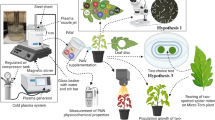Abstract
In recent years, a polymer tensiometer (POT) was developed and tested to directly measure matric potentials in dry soils. By extending the measurement range to wilting point (a 20-fold increase compared to conventional, water-filled tensiometers), a myriad of previously unapproachable research questions are now open to experimental exploration. Furthermore, the instrument may well allow the development of more water-efficient irrigation strategies by recording water potential rather than soil water content. The principle of the sensor is to fill it with a polymer solution instead of water, thereby building up osmotic pressure inside the sensor. A high-quality ceramic allows the exchange of water with the soil while retaining the polymer. The ceramic has pores sufficiently small to remain saturated even under very negative matric potentials. Installing the sensor in an unsaturated soil causes the high pressure of the polymer solution to drop as the water potentials in the soil and in the POT equilibrate. As long as the pressure inside the polymer chamber remains sufficiently large to prevent cavitation, the sensor will function properly. If the osmotic potential in the polymer chamber can produce a pressure of approximately 2.0 MPa when the sensor is placed in water, proper readings down to wilting point are secured. Various tests in disturbed soil, including an experiment with root water uptake, demonstrate the operation and performance of the new polymer tensiometer and illustrate how processes such as root water uptake can be studied in more detail than before. The paper discusses the available data and explores the long term perspectives offered by the instrument.
Similar content being viewed by others
References
Bakker G., van der Ploeg M.J., de Rooij G.H., Hoogendam C.W., Gooren H.P.A., Huiskes C., Koopal L.K. & Kruidhof H. 2007. New polymer tensiometers: measuring matric pressures down to the wilting point. Vadose Zone J. 6: 196–202.
Bear J. & Bachmat Y. 1991. Introduction to Modeling of Transport Phenomena in Porous Media, Kluwer Academic Publishers, Dordrecht, Boston, 553 pp.
Bernstein L. 1974. Crop growth and salinity, pp. 39–54. In: van Schilfgaarde J. (ed.), Drainage for Agriculture, Agronomy Series nr. 17, American Society of Agronomy, Madison, Wisconsin.
Dane J.H. & Hopmans J.W. 2002a. Hanging water column, pp. 680–683. In: Dane J.H. & Topp G.C. (eds), Methods of Soil Analysis. Part 4. Physical Methods, Soil Science Society of America Book Series nr. 5, Soil Science Society of America, Madison, Wisconsin.
Dane J.H. & Hopmans J.W. 2002b. Pressure plate extractor, pp. 688–690. In: Dane J.H. & Topp G.C. (eds), Methods of Soil Analysis. Part 4. Physical Methods, Soil Science Society of America Book Series nr. 5, Soil Science Society of America, Madison, Wisconsin.
Ferré P.A. & Topp G.C. 2002. Time domain reflectometry, pp. 434–446. In: Dane J.H. & Topp G.C. (eds), Methods of Soil Analysis. Part 4. Physical Methods, Soil Science Society of America Book Series nr. 5, Soil Science Society of America, Madison, Wisconsin.
Hillel D. 1998. Environmental Soil Physics. Academic Press, San Diego, London, New York, 771 pp.
Jury W.A., Gardner W.R. & Gardner W.H. 1991. Soil Physics, 5th ed. John Wiley & Sons, New York, Chichester, 328 pp.
Peck A. J. & Rabbidge R.M. 1966. Soil-water potential: Direct measurement by a new technique. Science 151: 1385–1386.
Peck A. J. & Rabbidge R. M. 1969. Design and performance of an osmotic tensiometer for measuring capillary potential. Soil Sci. Soc. Am. Proc. 33: 196–202.
Topp G.C. & P.A. Ferré. 2002. Thermogravimetric method using convective oven-drying, pp. 422–424. In: Dane J.H. & Topp G.C. (eds), Methods of Soil Analysis. Part 4. Physical Methods, Soil Science Society of America Book Series nr. 5, Soil Science Society of America, Madison, Wisconsin.
UNESCO-WWAP (World Water Assessment Programme), 2003. 1st UN World Water Development Report: Water for People, Water for Life. UNESCO (United Nations Educational, Scientific and Cultural Organization) and Berghahn Books, New York.
UNESCO-WWAP (World Water Assessment Programme), 2006. Water, a shared responsibility. The United Nations World Water Development Report 2. UNESCO (United Nations Educational, Scientific and Cultural Organization) and Berghahn Books, New York, 584 pp.
van der Ploeg, M.J., H.P.A. Gooren, G. Bakker & G.H. de Rooij. 2008. Matric potential measurements by polymer tensiometers in cropped lysimeters under water-stressed conditions. Vadose Zone J. 7: 1048–1054.
Warrick, A.W. 2002. Soil physics companion. CRC Press LLC, Florida.
Young M.H. & Sisson J.B. 2002. Tensiometry, pp. 575–608. In: Dane J.H. & Topp G.C. (eds), Methods of Soil Analysis. Part 4. Physical Methods, Soil Science Society of America Book Series nr. 5, Soil Science Society of America, Madison, Wisconsin.
Author information
Authors and Affiliations
Corresponding author
Rights and permissions
About this article
Cite this article
de Rooij, G.H., van der Ploeg, M.J., Gooren, H.P.A. et al. Measuring very negative water potentials with polymer tensiometers: principles, performance and applications. Biologia 64, 438–442 (2009). https://doi.org/10.2478/s11756-009-0077-8
Received:
Accepted:
Published:
Issue Date:
DOI: https://doi.org/10.2478/s11756-009-0077-8




